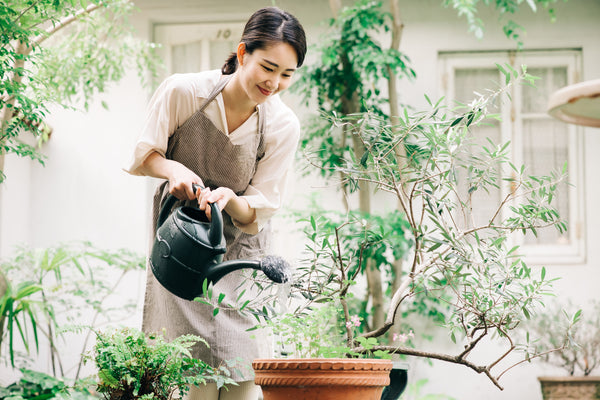From Vision To Bloom: How To Start Your Perfect Garden

Jump to:
Does the call of gardening beckon to you?
Dreaming of stepping out your back door to snip fresh herbs for dinner?
imagined a yard bursting with colorful blooms?
Starting a garden can turn these visions into reality, offering a rewarding hobby that is good for the mind, body and soul.
Looking to grow your own fruits or vegetables? Gardening is healthy, a great way to ensure the quality of your cooking ingredients!
Want to create a stunning flower display at your home? Your family, friends and neighbors will reap the benefits!
Do you desire a connection with nature? Gardening is an accessible and fulfilling pursuit!
In this handy Garden Starter guide, we'll walk you through the essential steps to start your own garden, from planning and preparation to planting and maintenance. We'll also introduce you to some high-quality Japanese tools that can make your gardening journey smoother and more enjoyable. Known for their precision, durability and ergonomic design, these tools embody the Japanese philosophy of craftsmanship and efficiency.
What Steps Do You Need To Take Before Creating Your First Garden?

Creating a garden is a fun hobby that rewards you with fresh produce, beautiful blooms and a sense of accomplishment.
So it’s really just a matter of grabbing a shovel and getting to work, right?
Well, not so fast.
Before you dive in, there are several crucial steps to consider. Let's explore each part of the gardening process, to ensure your gardening adventure gets off to the best possible start.
Deciding On The Type Of Garden
Just like building a skyscraper, before shovels go into the ground to make your garden, you need a blueprint first.
In this case, your garden’s blueprint is your vision for what the garden will ultimately look like. Only once this vision is onto paper (at least some kind of checklist or whatever works best for your gardening process), you can think about what kind of gardening tools you’ll need and how you’ll go about making that garden.
The first decision you'll need to make, of course, is what kind of garden you want to cultivate.
Are you dreaming of a bountiful vegetable patch, a colorful flower garden – or perhaps a mix of both? Your choice of garden will influence everything from plant selection to soil preparation and gardening tool selection.
For gardening novices, a small vegetable garden or a simple flower bed can be an excellent starting point.
Vegetable gardens offer the satisfaction of growing your own food. But really, it’s great to start small. No need to be running a farm here, after all, just start slowly and gradually, get the hang of it, then work your way into more cultivation as you get more comfortable with gardening.
Flower gardens and flower beds, meanwhile, can transform your outdoor space into a vibrant oasis. Even if you’ve got just a small patch of yard or patio to work with, the difference between bare space and a flower bed can be tremendous!
Choosing The Ideal Location For Your Garden
Once you've decided on the type of garden, it's time to find the perfect position.
Most plants thrive in areas that receive at least 6-8 hours of direct sunlight daily. Observe your yard throughout the day to identify the sunniest areas.
Consider factors like proximity to water sources, protection from strong winds and soil quality. If you're short on space, don't worry – container gardening on a patio or balcony can be just as rewarding.
Clearing The Ground: Choose Your Gardening Tools Strategically

With your location selected, it's time to prepare the area.
This often involves removing existing vegetation, rocks and debris. While it might seem daunting, the right gardening tools can make this task much easier.
For efficient weed removal, consider the Doukan One Handed Wood Handle Weeding Hoe 100mm. Its sharp blade and ergonomic design make quick work of unwanted plants.
For tougher weeds or compacted soil, the Doukan One Handed Weeding Hoe Jagged Blade Heavy Duty Weed Puller 80mm is an excellent choice.
If you're dealing with taller grass or weeds, the Doukan Stainless Steel Serrated Weeding & Grass Sickle 105mm is perfect for high ground clearance. Its serrated edge cuts through tough stems with ease, helping you clear your future garden plot efficiently.
Remember, careful gardening tool selection and thorough ground preparation set the stage for a healthy, thriving garden.
Take your time with this step – your plants will thank you later!
Testing And Improving Your Garden’s Soil
Good soil is the foundation of a thriving garden.
Start by testing your soil's pH and nutrient levels. You can use a home testing kit or send a sample to a local extension office for more detailed results.
Most plants prefer slightly acidic to neutral soil (pH 6.0-7.0). If your soil is too acidic or alkaline, you can adjust it with lime or sulfur respectively. Additionally, enhance your soil's structure and nutrient content by adding organic matter like compost or well-rotted manure.
Preparing Planting Beds For The Garden
With your soil improved, it's time to create your planting beds.
The Azui Handmade Carbon Steel Garden Hoe With Wood Handle 76mm is an excellent tool for this task. Its sharp blade easily cuts through soil, allowing you to form raised beds or level plots for planting.
When preparing beds, aim for loose, well-draining soil. Dig to a depth of 8-12 inches, removing any remaining roots or rocks.
If you're creating raised beds in the garden, build them 6-8 inches high for better drainage and easier access.
Selecting The Right Plants For Your Garden

Now comes the exciting part – choosing what to grow!
Consider your climate, the amount of sunlight your garden receives and your personal preferences. For beginners, it's often best to start with plants that are well-suited to your area and relatively easy to grow.
If you're starting a vegetable garden, consider staples like tomatoes, lettuce, peppers and/or herbs.
For flower gardens, a mix of annuals and perennials can provide color throughout the growing season.
Also, don't forget to check the mature size of plants to ensure proper spacing.
Shovels Down!: Planting Your Garden
With your beds prepared and plants selected, it's time to start planting.
Follow the spacing guidelines for each plant, and consider companion planting to maximize space and promote plant health.
For transplanting seedlings or small plants, the Tomita Nisaku Transplanting Tool Stainless Steel Root Cutter 1241 is invaluable. Its sharp, curved blade makes it easy to dig precise holes and cut through any circling roots, encouraging healthy growth in your garden.
Proper Garden Watering Techniques

Proper watering is crucial for your garden's success.
Most plants prefer deep, infrequent watering as opposed to frequent light sprinkles. This encourages roots to grow deeper, making plants more resilient to dry spells.
The Trusco Galvanized Watering Can 6 Liters CGI-06 is highly recommended for controlled watering. Its long spout allows you to direct water to the base of plants, avoiding wet foliage which can lead to disease.
Mulching For Garden Protection & Growth Promotion
Aside from the right gardening tools, mulch can be a gardener's best friend.
Mulch helps retain soil moisture, suppress weeds and regulate soil temperature.
Apply a 2-3 inch layer of organic mulch like wood chips, straw or compost around your plants, being careful not to pile it against plant stems.
Maintaining Your Garden For Long-Term Growth & Beauty
Regular maintenance keeps your garden healthy and productive.
This includes weeding, pruning and monitoring for pests or diseases.
The Chikamasa Pruning Shears T-550 are a fantastic gardening tool for precise pruning, helping you shape plants and remove dead or diseased growth.
When Is The Best Time To Start A Garden?

When looking to start a garden, there are a number of timing factors to consider.
Seasonal Considerations for Starting a Garden
The best time to start your garden depends on what you're growing and your local climate. In general:
- Spring is ideal for most garden startups, especially for vegetables and annuals
- Summer can work for quick-growing crops and heat-loving plants
- Fall is great for cool-season vegetables and planting spring-blooming bulbs
- Winter is perfect for planning and preparing for the next growing season
Also, a lot of this depends on which part of the country/world you live in.
Your specific region plays a crucial role in determining planting times. Consider your area's first and last frost dates, and research the best planting times for specific crops in your climate zone.
Planning for Gardening Success
Regardless of when you start, proper planning is key.
Use the off-season to research, design your garden layout and prepare your tools & supplies.
This way, you'll be ready to spring (no pun intended) into action when the ideal planting time arrives.
Let’s Get That Garden Started!
Starting a garden is a process of discovery, patience and joy.
With the right preparation, tools and care, you can transform a patch of earth into a thriving ecosystem. For years ahead, you’ll be able to create and enjoy your garden’s beauty and sustenance, and experience a deeper connection to nature.
Remember, gardening is as much about the process as it is about the results. Don't be discouraged by initial setbacks – every gardener, no matter how experienced, is always learning and adapting. Embrace the challenges, celebrate the successes and (most importantly) enjoy the rewarding experience of nurturing life from seed to harvest.
As you embark on your gardening adventure, investing in quality tools can make a significant difference in your efficiency and enjoyment. The precision and craftsmanship of Japanese gardening tools can elevate your gardening experience, making tasks easier and more pleasurable.
It’s time to grab those gardening tools, get your hands dirty and watch as your garden grows from a dream into a beautiful reality!

0 comments